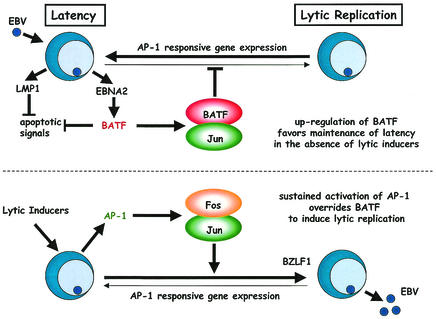FIG. 9.
Proposed function of BATF as a positive modulator of EBV latency and as a deterrent to lytic-cycle entry. The EBNA2 protein is expressed immediately following infection and utilizes its transactivator function to trigger cell proliferation as well as the direct induction of BATF, which functions in the context of a BATF: Jun heterodimer to restrict cell growth, inhibit AP-1 target gene expression, and, together with LMP1, block apoptosis. Exposure to an appropriate lytic-cycle inducer (e.g., TPA) enhances intracellular AP-1 activity through new protein synthesis (Fos) and the posttranslational modification of resident AP-1 family members (Jun). The resultant sustained increase in AP-1 activity is sufficient to overcome the BATF inhibition of multiple AP-1 target genes (including BZLF1) and promote production of the immediate-early transactivators required for lytic-gene expression.

